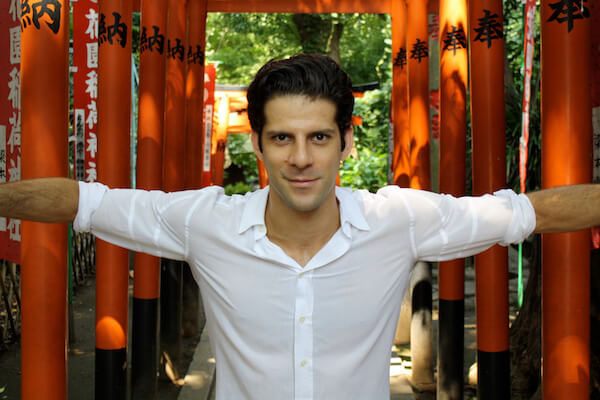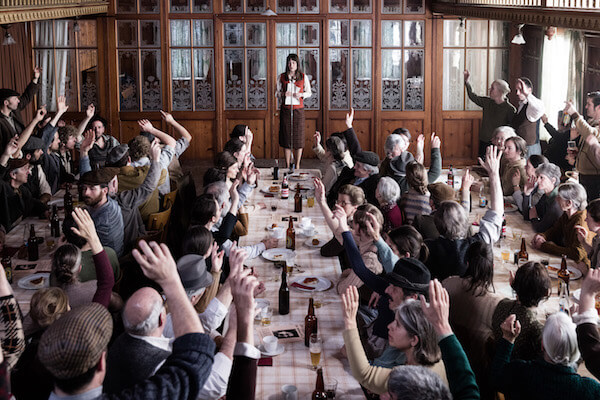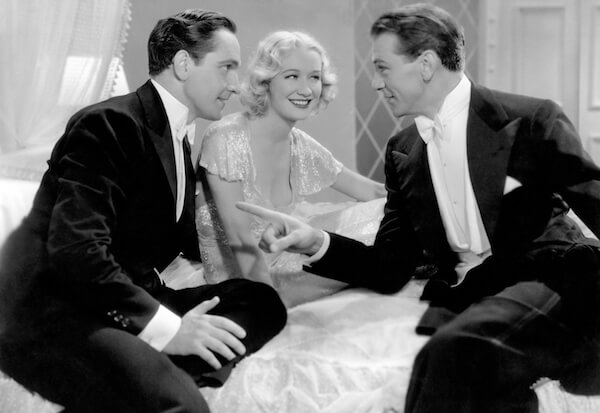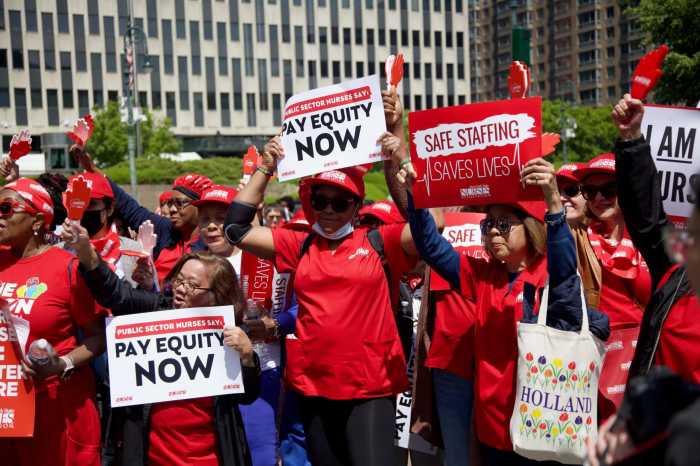Gene Tierney in John M. Stahl’s “Leave Her to Heaven” (1945). | FILM FORUM
The mesmerizing world of film noir offers the perfect dark, cool respite from summer’s heat and, starting July 18, Film Forum presents “Femmes Noir” (209 W. Houston St., through Aug. 7, filmforum.org). It’s a comprehensive run-down of titles featuring Hollywood’s most iconic actresses being alluring, mysterious, treacherous and even downright murderous.
The imperturbably gorgeous Louise Brooks in G.W. Pabst’s pitiless Frank Wedekind adaptation “Pandora’s Box” (1929; Jul. 21) kicks things off silently in 1928, but the real genre originator was probably Mary Astor in “The Maltese Falcon” (1941; Jul. 25). This classically beautiful, always underrated actress, every bit the equal of Davis, Hepburn, or Stanwyck, but with far more range than any of them, made Dashiell Hammett’s Brigid O’Shaughnessy an intriguingly ladylike, ultra-feminine, and delicate damsel in distress, whose dainty facade could suddenly drop in an instant — as when she viciously attacks Peter Lorre’s oily homosexual Joel Cairo in their competitive race for that titular treasure. Her canny director, John Huston, advised her to run around the set before shooting a scene as, in his opinion, compulsive liars like Brigid were always a little out of breath.
Astor’s Brigid was an archetype, but it’s amazing how varied the villainnesses are in this extremely well-played series, with their dazzlingly diverse displays of sensuality. There’s Claire Trevor’s hard-edged, sour lemon acerbity in “Murder, My Sweet” (1944; Jul. 25); Gene Tierney’s utterly glacial brand of evil in “Leave Her to Heaven” (1945; Jul. 20-21); Lana Turner’s pouting petulance in “The Postman Always Rings Twice” (1946; Jul. 18-19); Joan Bennett’s abrasively common trampiness in “Scarlet Street” (1945; Jul. 24), and Peggy Cummins’ unformed nymphet precocity in “Gun Crazy” (1949, Jul. 27).
Film Forum looks at the ladies of noir; a dancin’ man creates a true legacy
The two-ton lugubriousness, undeniably hypnotic, of Eternal Victim Joan Crawford is represented in “Sudden Fear” (1952, Jul. 29) and her definitive rags-to-riches saga “Mildred Pierce” (1945, Jul. 18-19, 31) — although it’s impossible to ever take the latter seriously again if you see Carol Burnett’s “Mildred Fierce” take-off. Barbara Stanwyck was perhaps the absolute queen of the genre, insanely malevolent in the creepy near-Greek tragedy “The Strange Love of Martha Ivers” (1946; Jul. 31) and, of course, in the greatest of all noirs, “Double Indemnity” (1944; a 70th anniversary celebration Aug. 1-7), in which she combines an anklet, hilariously worn sunglasses, tight angora sweaters, and one of the worst wigs in all cinema to make hateful histrionic history.
Marilyn Monroe in Henry Hathaway’s “Niagara” (1953).| FILM FORUM
Stanwyck’s direct opposite would be the luscious Rita Hayworth who, in “Gilda” (1946, Jul. 23) and “Lady from Shanghai” (1947, Jul. 24), seems the epitome of softly compliant, voluptuous womanhood, of whom it’s nigh impossible to believe anything bad. Marilyn Monroe in “Niagara” (1953; Jul. 22) continues this nuzzlingly sexy tradition, with perhaps a soupçon more of flint to her nature.
The more modern era is represented by the searingly ferocious Glenn Close’s “Fatal Attraction” (1987, Jul. 30) with its classic female stalker line, “I’m not going to be ignored!” There’s also the strenuous Kathleen Turner in “Body Heat” (1981, Jul. 30), a good example of how not to do it, for the essential noir dame should never let the sweat show.
But I can’t let my little tribute to these delicious dames end without saluting my favorite lady among them, Marie Windsor’s Sherry in Kubrick’s “The Killing” (1956, Jul. 26). She’s an unmitigated c-word in her cruelly dismissive (and side-splitting) scene with her chump of a husband (eternal chump Elisha Cook, Jr.), but so entertaining with her relentless put-downs and unbearably humpy secret stud on the side (a pre-Ben Casey Vince Edwards, positively drool-inducing trade here).
After a lifetime in showbiz as a super-prolific dancer and director, Grover Dale, who turns 79 on July 22, has become the Answer Man. With his website, “Answers4Dancers.com,” whose mission statement is “to empower dancers and choreographers to think, to grow, and to create satisfying careers for themselves,” he is doing an invaluable service to performers of all ages.
“I guess I’ve created this for myself, like a father figure to hundreds of dancers on the Internet. I say to the kids, ‘Look, you’ve already got everything you need inside you. It’s just going to keep coming out if you allow it. Be present, get in the room with your colleagues,’ and they are really creating the website with demo reels that are remarkable. They’re building careers with this technology they’re comfortable with, and I’m just sorry I won’t be around 40 years from now to see how their careers developed because they’re producing themselves.’
Dale’s story started in McKeesport, Pennsylvania, a steel town south of Pittsburgh, and he showed me a picture of himself as a tiny child sitting on some steps outside of a ramshackle house.
“This is where my creative life began on these steps my grandfather built,” he said. “They were my safety zone where I would sit, and they saved me from what was going on in our house. My mother had married this alcoholic guy who worked in the steel mill and it was crazy.
“Somehow, I just longed to go somewhere else, and one day a neighbor lady saw me sitting there and said, ‘Grover, if you take my son Jimmy down to the dancing school, I’ll pay you a dollar a week and also pay for your tap class. That started everything, and little did she know she was my dance angel, launching my life, and I wish I remembered her name.”
Grover Dale. | STHANLEE B. MIRADOR
Dale ended up starting his own dance school at 15 (“with 120 dancers, incredible!”), but “I walked away from my business — it never dawned on me that I could sell it — to come to New York in 1953. I got a job selling hot dogs and orange juice at Nedick’s and quickly landed a job as a dancer on ‘The Jackie Gleason Show.’ There were then nine network musical shows in New York, and I worked alongside Paul Taylor, Herbert Ross, Joe Layton, Tony Mordente, and so many others.
“When Tony and I, who were on Broadway in ‘Lil Abner,’ landed our jobs in ‘West Side Story,’ the chorus boys pinned us down on the dressing room floor and shaved our crotches, so we would remember them for the next four months, itching and scratching in our dance belts! I played Snowboy in ‘West Side,’ and that first night, when the curtain came down, there was complete silence, so we all thought it was a flop. Then the curtain went up and the audience went crazy.
That started a special relationship between the show’s tortured genius director, Jerome Robbins, and Dale, who went from being his dancer to his prized assistant.
“I worked for him for over 30 years, and the shit could hit the fan, baby, but he had other sides to him,” he recalled. “When his show ‘Jerome Robbins’ Broadway’ came up, he wanted to hire me and promised I would get co-director billing. He said, ‘I feel that if something goes wrong and I can’t make it, I know that you’ll take care of it, you’re my insurance policy.’
“The heart of that man, and the wisdom! He knew what would touch an audience, and when he choreographed his process never involved using a mirror like most choreographers. It got to the point where I would be standing behind him and just by watching the back of his neck could almost sense what he was going to do.
“We couldn’t afford to take it out of town, so we had this nine-month rehearsal period up in Purchase and got to do two performances on a bare stage with little lighting and no sets or costumes. We stripped the show down and it was spectacular, the way it should have been done, with the costs split in half and producers loving us forever.
“My job was to storyboard the entire conception, but when I finished and went to see Jerry, he was in tears. ‘Grover,’ he said, ‘I can’t do it. All the money has been committed to build the sets and I promised the writers of all those shows we’re using that we would do it exactly as the originals.’
“He caved in and that was the beginning of a change in our relationship. My gut tells me that because I knew the truth of what that show should have been, it then became hard for him to be around me. It was difficult because, every time he saw me, I was like a reminder of this, and I still have those drawings.”
Dale’s Wikipedia entry lists his personal life as having included relationships with Anthony Perkins and actress Anita Morris. “Just those two?” Dale chuckled. “Ten years with Tony and 20 with Anita. But they haven’t even touched the tip of the iceberg!”
“At a certain time, I was marriage material, but I had no intentions of being that until I met Anita. In response to a Village Voice ad I had placed seeking dancers for the Lenox Arts Center, she sent a bizarre picture of herself in a white plastic face mask and black leotard, bent over in a back bend with her arms on the floor. She was the leading lady of a mime theater and I thought, ‘Oh, please, what nerve!’
“There were two piles of dancers’ photographs on my desk, a ‘yes’ and a ‘no,’ and my hand was on its way to the ‘no’ pile when it stopped. I had to meet this person and see who the fuck would do this. A week later she shows, this stunning redheaded beauty and literally my life was changed in a second, like with my dance angel. I never identified as bisexual, I always just said I’m gay, but I just happened to fall in love with a woman, and she wasn’t my first. I never went to bed with Liza, but we were well on our way, if I could have just gotten her husband [Peter Allen] off my back. He was such a trip!
“I met Tony when I was cast as understudy to him in the show ‘Greenwillow.’ I had first seen him in a magazine and thought, ‘That looks like me! Young small-town kid.’ He did ‘Psycho’ right before our show, and that film was a blessing and a curse for it typecast him forever. I remember how wonderful he was in films like ‘Friendly Persuasion,’ and he could never get a part like that again.
“It was the 1960s and we lived together but never went out to restaurants together. I loved his mother, and I met Anita when I was with Tony. I remember driving into the parking lot of the Arts Center and she was standing there, and when she saw me she had that look of when a three-year-old looks at you and just runs to you. No one had ever done that and I was like, ‘Dear God,’ and that was the beginning. We had our son, Badge, in 1978.
“I left Tony and then he met Berry Berenson, and we all got married within three weeks of each other. Everyone we knew thought we were insane, that we had some kind of agenda with these two women, and we all lived together in the same house for a while in Chelsea on 21st Street. We took the garden apartment and they were in the main part of the house. Our families got together on certain occasions. They were very social, so it was a regular thing to go to their LA house and hang out.”
Perkins died of AIDS in 1992, Morris succumbed to ovarian cancer in 1994, and Berenson perished aboard American Airlines flight 11 on 9/ 11, making Dale the sole survivor of this fascinating menage.
“Anita’s death was devastating and it took me five years before I saw anybody, a lot of healing. It never occurred to me that she would go before me. I was nine years older and it was something I needed to go through, having never dealt with losing somebody like that.”
Dale appeared in Noël Coward’s “Sail Away” in London’s West End in 1962 : “I was doing ‘West Side Story’ on my first trip to London. The stage manager announced, ‘There’s a man named Noël Coward coming up to your dressing room.’ Everybody laughed in disbelief and then he appeared and said, ‘Young man, I would like to invite you to supper to talk to you about playing the juvenile lead in my new musical.’ Dinner turned out to be with Marlene Dietrich and Alain Delon! I couldn’t speak, so Noël said, ‘Come to my hotel room tomorrow and I will play you your songs.’ Which he did, he was so wonderful, and it was great to see someone at his level be able to say, ‘Something’s wrong with this show.’ And then listen to the choreographer and have him take over the direction, which Joe Layton did to make it work beautifully. They had two female leads and they took one out, and kept Elaine [Stritch].
“Speaking of my romances, Elaine and I were engaged to be married in London. What were we thinking? We even got a marriage license! She never talks about that one, but she was so much fun to live with, her laugh! Those were her drinking days. We had a house on Anderson Street right behind the pub, so it was the perfect location. So funny because all I wanted to do was meet men and I couldn’t get anybody’s attention. And then, 30 years later, some actor writes on the Internet that every gay man in London wanted me! Ohmigod, how stupid could I have been!”
Contact David Noh at Inthenoh@aol.com, follow him on Twitter @in_the_noh, and check out his blog at http://nohway.wordpress.com/.






































